Link: https://wentworthreport.com/australias-defence-name-yourenemy/
Please see link above for source text.
Australia’s Defence 1: Name Your Enemy
by David Archibald24 April 2024
The Defence Strategic Review released a year ago named global warming as a threat on page five but didn’t name China as a threat until page nine. There is only one threat we have to worry about and its name is China. China has been making plenty of threats for over 20 years now but these have been ignored because it would be inconvenient to take them seriously.
Actually, China’s threats started before WW2. They have been in abeyance until they had the resources to act on them. Figure 1 shows a map from a Nationalist primary school textbook in 1938, showing where they thought China’s borders should be:

China’s ambitions extended as far south as Singapore. Nigh on four generations later, nothing much has changed. China has territorial disputes with most of its neighbours:
Figure 1: China’s imperial ambitions as in 1938 from a Nationalist primary school textbook
The map isn’t completely correct. At their last meeting, Xi asked Putin to hand Vladivostok to China. The situation between Russia and China is that same as that between Germany and Russia during the Molotov-Ribbentrop Pact in WW2. China will attack Russia at some point and both parties know it. Xi has made no secret of the fact that he wants to go down in history as the new Yellow Emperor, Huangdi of 2704 BC. At the 19th Party Congress, Xi’s speech included these words:
The wheels of history roll on; the tides of the times are vast and mighty. History looks kindly on those with resolve, with drive and ambition, and with plenty of guts; it won’t wait for the hesitant, the apathetic, or those shy of a challenge.
Xi intends to provide the ambition that will get some history written in other people’s blood. To that end, he has told the Chinese people to stop whining and “learn to eat bitterness.”
Figure 2: Countries that have territorial disputes with ChinaThey will be eating plenty of bitterness because some other things will be in short supply. The blame for that can be put on Chairman Mao who stopped China from adopting a one child policy because he thought that history belonged to the ‘big battalions.’ Mao died in 1976 and the one child policy was imposed in 1980. But it was a bit late. China’s population was 600 million in 1960 and blew out to the current 1,300 million. They can only feed some 600 million people on a normal diet. China was almost completely vegetarian up to early this century, when the industrial expansion funded the import of soybeans to convert into chickens and pigs. An account of the lives of coal miners in northeast China in the 1990s mentioned that the miners only ate meat twice a year. Both the US and Brazil grow and export a lot of soybeans, most of which is sent to China. China’s soybean imports, at 100 million tonnes per annum, is the protein equivalent of 300 million tonnes of wheat.
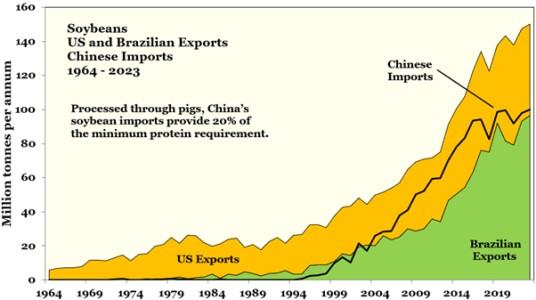
Now China imports 41% of the plant protein that its agricultural system is based on, in effect feeding 530 million people. Normally it would be illadvised for a country in that situation to start a war which would see those
Figure 3: US and Brazilian Soybean Exports and Chinese Imports 1964 –2023imports terminated.
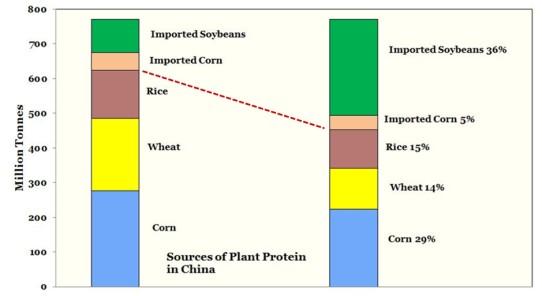
Tonnage in hundred million tonnes is the bar on the left. The bar on the right shows how that translates to percentage of total protein. Xi was confident that his first war would be over quickly and that the flow of grain and soybeans towards China would be effectively uninterrupted. Then the Ukraine War showed how bad it could get. China expected Russia’s invasion to have conquered Ukraine in a week or so; instead it is now into its third year as a giant meat-grinding exercise with effective sanctions on Russia and a Western polity united against Russia. And it will be so easy to interdict the flow of soybeans toward China that starts 20,000 km away in the highlands of Brazil.
Xi’s really wants his war. So, three solutions have been devised to get China through it. Firstly, China will go vegetarian for the duration of the war. Secondly, China will increase grain production by 50 million tonnes per annum. China has hired 80,000 agricultural inspectors who are going around rural areas and ripping up orchards, bamboo groves, forests and any other ground that can be repurposed for growing grain. They are deforesting hillsides with 30˚ slopes in an attempt to plant them to grain.
Figure 4: Sources of plant protein in ChinaSimilar things were done during the Great Leap Forward, which resulted in some 30 million deaths. Thirdly, China has an agreement with Russia to ship grain across the Trans-Siberian Railway. This last arrangement may be good for about 50 million tonnes per annum, based on the available rolling stock. Nevertheless, there will be a scarcity of pork during Xi’s war and pork is important in Chinese culture. The symbol for a house in the Chinese language is a pig with a roof over it. The regime keeps a strategic stockpile of frozen pork and live pigs to ameliorate any shortages.
A sign that Xi is directing all the resources of China towards his goal of being able to start his war is that a greenbelt around the city of Chengdu in western China, that had been built at a cost of seven billion dollars so that the citizens of Chengdu could have a civilised life, was bulldozed soon after it was completed. This enabled 40,000 hectares to be put under the plough, to grow about 250,000 tonnes of grain per annum. The Chengdu exercise says that Xi is not bluffing about starting a war.
China is making great sacrifices to be able to have a plausible chance at winning Xi’s war of choice. Japan made a similar choice in WW2. Japan couldn’t grow enough food to feed itself from within its own borders so it needed a constant shuttle of freighters to supply the shortfall. Its precarious food supply didn’t stop Japan from attacking the rest of Asia. Appropriately the campaign near the end of the war to use B-29 bombers to drop sea mines in Japanese waters to choke off Japan’s food supply was called ‘Operation Starvation.’ It worked. The Japanese diet dropped to 1,680 calories per day on average.
The Chinese Communist Party lifted some people out of poverty over the last 25 years but at least twice as many were left behind. Some 300 million people, mostly in six coastal provinces that manufacture things for trade with the world, now have a much higher standard of living, but at least 600 million people survive on less than US$141 per month. It will be the 300 million we will be fighting in China’s war, not the whole population of 1,300 million.
China has problems which will take the rest of the century to fix, if at all. For example, the situation in rice production is intractable. China produces
147 million tonnes of rice per annum. Nearly 95% of that grown under traditional puddled transplant conditions. Without hand planting of rice, China’s grain production would plunge. There are 425 million agricultural workers in China. So, one farm worker feeds only himself and two other people. Rice production can’t be mechanised without production falling. By comparison, the percentage of the population in agriculture in Western countries is usually just two percent — one agricultural worker, on average, feeds 49 others.
Besides grain, China has another major fragility. Their economic miracle of the first 15 years of this century was partly due to cheap labour, but to a large extent it was due to cheap energy from coal. China’s coal production is now 4.5 billion tonnes per annum, with imports of a further 500 million tonnes per annum. Their coal burn is the energy equivalent of 50 million barrels per day of oil. China has now burned through some 130 billion tonnes of coal and has an equivalent amount left. Having burnt through half its original coal endowment, coal production in China should now tip over into decline, with rising production costs as mines go deeper.
Support for that outlook comes from this graphic of Chinese coal mine reserves by depth:

Most of China’s coal production is from underground mines, with mining cost increasing with depth. It is said that the average depth of Chinese underground coal mines is increasing by 10 to 25 metres per annum. The average dip of coal seams mined is 13˚. The figure is representational in that shows about 800 billion tonnes have been mined so far above 600 metres mine depth. Total Chinese coal production to date is more likely to be 130 billion tonnes. What can be interpreted from it is that some 80% of coal reserves above 600 metres mine depth have already been mined, as has 60% of the coal between 600 metres and 1,000 metres depth. The remainder of China’s original coal endowment is much deeper and therefore will be more expensive to mine.
That phase of cheap energy supporting economic growth is now over. China’s power price for industry now rising. One consequence of that is that the cost of renewable energy, solar panels, and wind turbines will go up as their production costs rise in tandem with the Chinese coal price. There is some support for this prediction — Chinese coal imports have started rising strongly in the last few years. To fill their production contracts in 2024, Chinese coal mines are tending to wash their coal less, producing the contract tonnage but with a lower calorific value. One Chinese academic has proposed the view that China has effectively burnt through its coal endowment. It used that energy in a civilisational quest to build apartment blocks, which will wear out in time and need to be pulled down in 50 to 80 years. So, in a sense, the whole exercise is one of futility.
China started preparing for war as soon as Xi was appointed President. One of the first things he did as President was order China’s maritime assets to start harassing Japan in the Senkaku Islands, as shown by the following graphic of Chinese incursions into Japanese waters. This graph is the pulse of war in Asia. Until this graph goes to zero, war is coming to Asia:

The red bars are Chinese intrusions into Japanese territorial waters. The blue line is Chinese incursions which goes out a further 12 kilometres.
If war is coming to Asia, what does the correlation of forces look like? Here is the alignment of the economic/cultural blocks around the planet:
 Figure 6: China’s baiting of Japan around the Senkakus
Figure 6: China’s baiting of Japan around the Senkakus
China doesn’t have friends. It only has enemies and those countries that are indifferent or can be rented.
If we look at Asia in detail, Figure 8 shows how the correlation of forces stacks up:
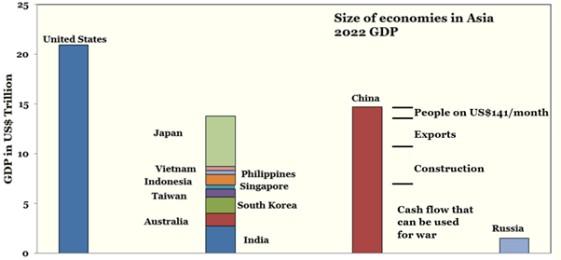
8:
The anti-China grouping is now twice as large as China, by GDP. Of that Chinese GDP, some one trillion US dollars is contributed by the very poor who can barely afford to clothe themselves — so it won’t be contributing to the Chinese war effort. 20 percent is exports, which will stop as soon as the war starts 30% is construction, which will also stop once the war starts. Looked at this way, China, while large, is not as formidable as it is portrayed and has a number of fragilities. Similar shortcomings didn’t stop Russia from the foolish undertaking of attacking Ukraine. Russia decided to attack Ukraine despite having a GDP that is only slightly larger than Australia’s. A large chunk of Russian society is quite backward — for example, 20 percent of Russian dwellings lack an indoor toilet.
Chinese industrial production has also stopped expanding. In fact, it is now shrinking, as shown by the following graphic of industrial plant utilization:
Figure The correlation of forces – relative GDP in Asia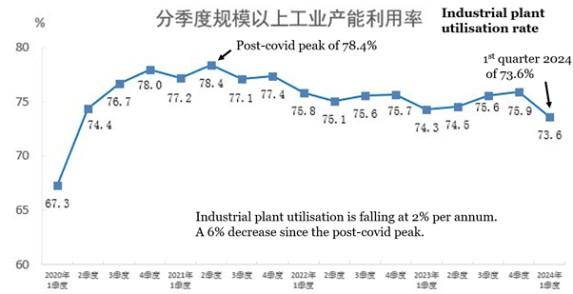
Now, having established that China is intent on war and that this undertaking is ill-advised, foolish and likely end in tears, which country will China attack first? China has said that it will be Taiwan but it should be borne in mind that China lies about most things, that deception is a big part of the Chinese modus operandi, and that China would prefer to practice on a country that doesn’t have defence treaties with third parties. If it is Taiwan, Taiwan will fight because China will kill the entire Taiwanese political class down to provincial council members. The rest of the population will spend their remaining lives having an hour per day spent on studying “Xi Jinping thought,” which will be a living hell.
Taiwan has two monsoon seasons and so there are two weather windows for an invasion — May to July and the month of October:
China says that it will invade Taiwan but has laid very little concrete to that end. There have been no helipads laid on Chinese islands in the Taiwan
Figure 9: Chinese industrial plant utilizationStrait despite the fact that such things would be very useful in an assault on Taiwan. China has built at least one expeditionary helipad in the Nanji Islands for an attack on the Senkaku Islands, but nothing opposite Taiwan.
Not much concrete has been laid for an invasion of Taiwan but plenty of concrete has been laid for invading Vietnam. The prime example of this is this base built 10 kilometres north of the border:

Construction of this base started a decade ago. What marks it as being different from other buildings in the region is the fact that the roofs are red, while all commercial buildings have blue roofs. This means that they were built at the command of an authority from outside the region, which also organized the steel supply. The oldest roofs have now faded to grey.
The purpose of the complex is to shield PLA armoured units from satellite observation. Units would move in at night, with the troops barracked in the small, narrow buildings in the centre. China has also built artillery pads right along the border:
Figure 10: Base built for attacking Vietnam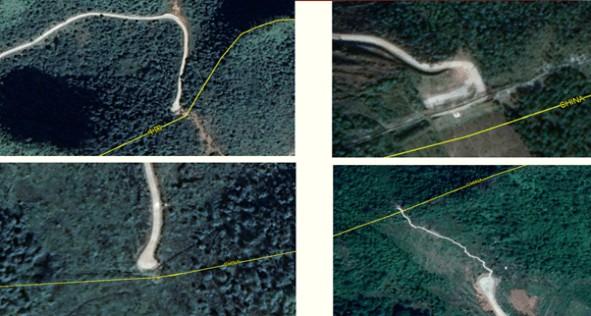
China is also building a SAM site just 20 kilometres from Vietnam, within range of Vietnamese artillery:
 Figure 11: Chinese artillery pads along its border with Vietnam
Figure 11: Chinese artillery pads along its border with Vietnam
The fact that they are building it so close to the border suggests that they think their invasion will go exactly to plan, so it won’t be in range for long. Note the running track that most PLA facilities come with.
China has been attacking Vietnam since 116 BC. The last time they attacked was in 1979. In that exercise China lost 30,000 troops in three weeks, then withdrew. They kept shelling Vietnam until 1991. The Chinese modus operandi is to launch a surprise attack and call it a defensive pre-emptive strike. The attack routes used in the 1979 war are shown in the following figure. They will use the same ones again, constrained by the difficult topography.
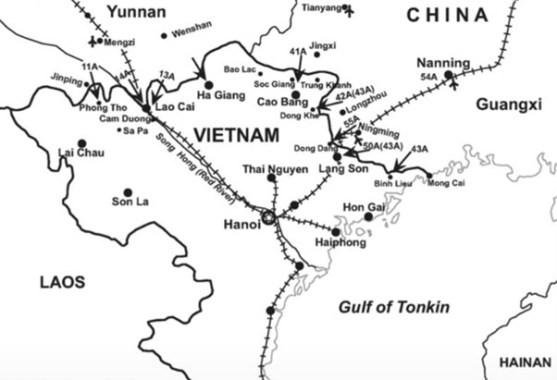
There is another reason why China is likely to attack Vietnam first. China claims the whole of the South China Sea while Vietnam has 47 bases in
Figure 13: Chinese attack routes in 1979China’s claim area. This graphic also shows the Chinese, Malaysian, Filipino and Taiwanese bases:
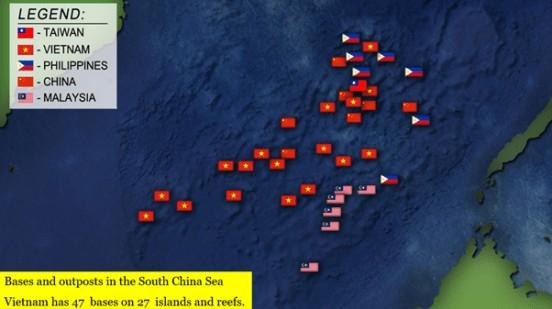
The Spratly Islands also have far more airfields than the
perception:
 Figure 14: Bases in the South China Sea
public’s
Figure 14: Bases in the South China Sea
public’s
All three of the Chinese airfields in the Spratly Islands are 10,000 feet long and built on artificial islands created by cutter-suction dredges from lagoon sediments.
While China has been attacking Filipino ships supporting their bases on the eastern side of the Spratly Islands, and this has received a lot of public attention, they have left the Vietnamese bases alone so far. This is because they know the Vietnamese will shoot back. In fact, all the Vietnamese manning these bases have been told that it will be a fight to the death when China attacks.

Vietnam’s bases in the Spratly Islands show a wide range of building styles. One particular style is quite interesting. They are small bases in shallow water. Each bases has two arms coming out so that the defenders can fire down on Chinese forces in the water. A second base is built 100 metres from the first one, with an elevated walkway in between, so that the two buildings provide each other with mutual fire support:
Figure 16: Four Vietnamese bases in the Spratley Islands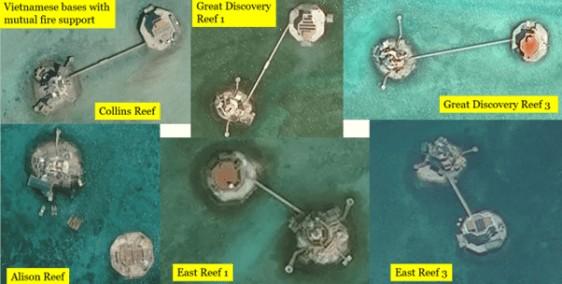
Photos of these bases show a lot more dogs than you might expect. It seems that the dogs are used to warn of PLA attacks by frogmen at night. When China’s war starts, each of these bases will have its own fate. They will absorb some of China’s initial missile salvo, so they are protecting us too.
Vietnam has another attraction for China. While the result of an attack on Taiwan is binary — it will be obvious whether or not China has won — an attack on Vietnam could be like the last one. China may call it off after a few weeks and announce a victory. China and Vietnam are both repressive communist dictatorships. The animus between them is racial rather than based in philosophy. When China’s economy was only ten times larger than Vietnam’s, Vietnam was reasonably confident that they could hold China off. With the temporary liberalization of China from 2000, the economic disparity widened and Vietnam became concerned that it would be overwhelmed. So Vietnam liberalized its economy too and its economy has been growing rapidly.
The extra cash has enabled Vietnam to spend more on its bases in the Spratly Islands. For example, this satellite photo from late 2023 is of the base on Namyit Island:
Figure 17: Vietnamese bases with mutual fire support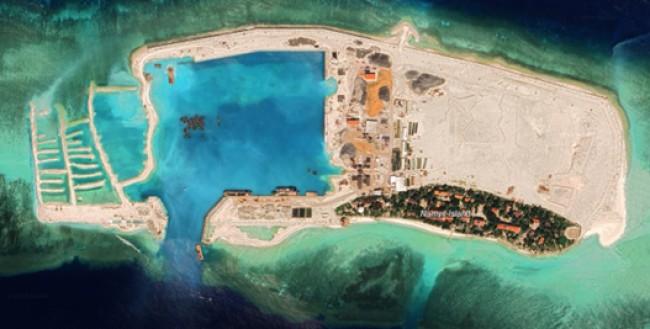
The green area on the lower right is the original island base. Being enlarged will enable the base to absorb a far greater amount of Chinese artillery. Given that Vietnam is expanding bases on islands that China says are rightfully theirs, Xi would consider this to be the height of insolence. On the 8th March, 2024, Xi announced that the PLA “should coordinate the preparation for maritime military conflicts, the protection of maritime rights and interests, and the development of the maritime economy.” This opaque language has been decoded to mean war over the South China Sea.
In Vietnam’s case, China’s attack will be supported by an armoured assault into northern Vietnam. China will undertake not to withdraw until Vietnam gives up its bases in the Spratly Islands. If it does so, Vietnam’s ships will have to hug the Vietnamese coast to get anywhere. This would add 3,000 km to a voyage to Japan, for example. The Chinese boot would be stomping on the Vietnamese face forever. Vietnam would rather fight.
The Filipino bases in the Spratly Islands are modest affairs, the most famous of which is their base on Second Thomas Shoal:
Figure 18: The Namyit Island base being enlarged by cutter-suction dredging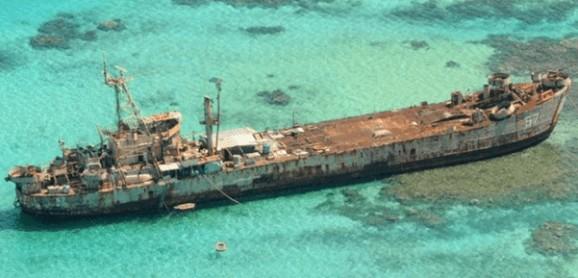
This vessel started its life as a Landing Ship Tank in 1944 and served in the Pacific. The United States also used it in the Vietnam War, after which it was transferred to the Philippines Navy. It was run up on Second Thomas Shoal in 1998 to make a base with 12 Filipino marines living on it ever since. Chinese vessels try to interdict Filipino ships resupplying it. China is annoyed that the Philippines has not given up this base yet.
Vietnam is handicapped by its constitution, which doesn’t allow defence treaties with other countries. The good news is that Japan has started talks with the Philippines about basing Japanese troops there. Japan knows that its best chance of survival is being involved in China’s first war from day one, so it wants to have tripwire troops there. The Philippines has also clarified that the trigger for invoking its defence treaty with the United States is the death of a single Filipino soldier by any foreign power, meaning China.
David Archibald is the author of The Anticancer Garden in Australia.
Figure 19: The Sierra Madre on Second Thomas Shoal